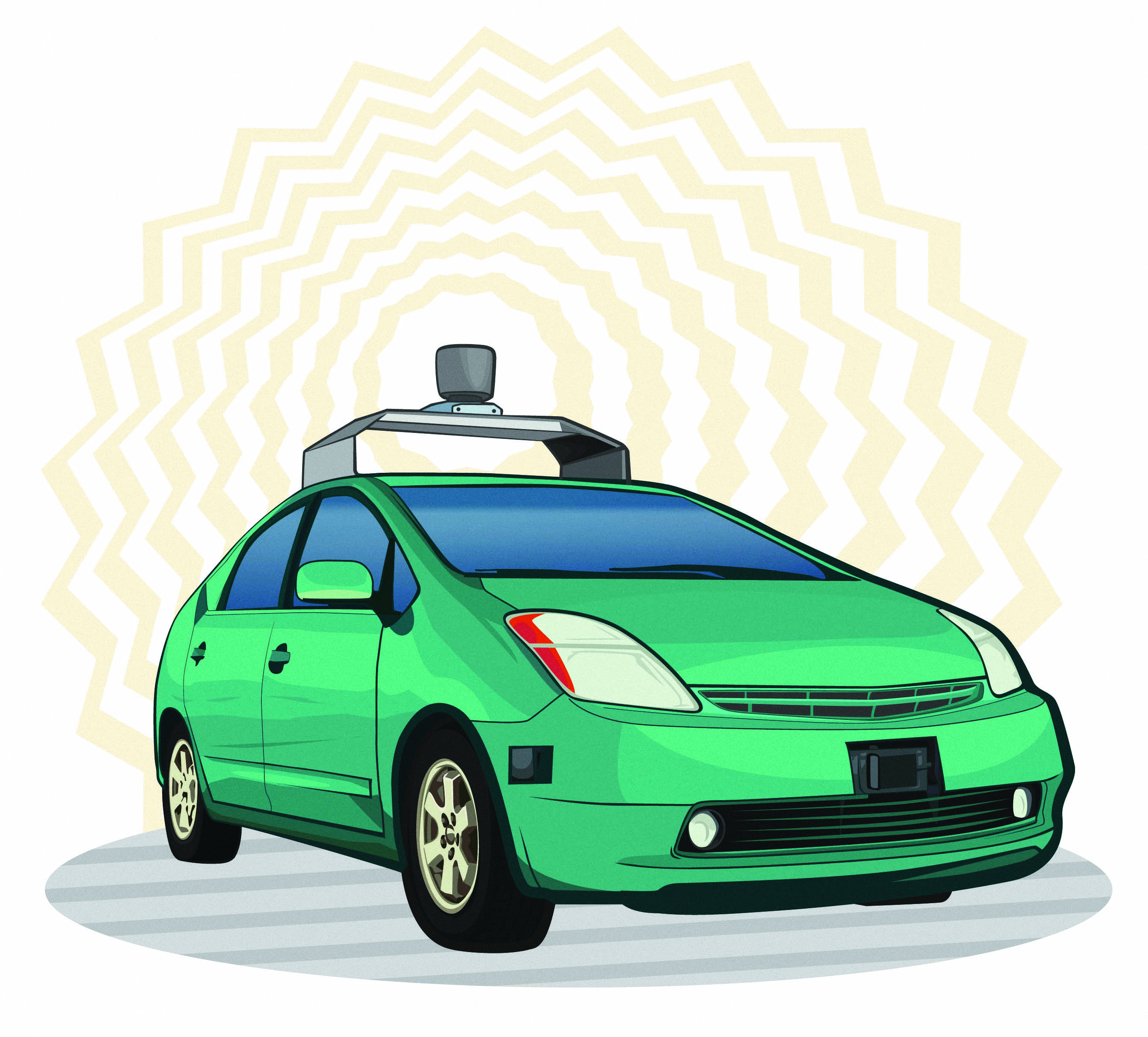On Tuesday, Sept. 25, the state of California signed a bill into law that will allow self-driving cars on California roadways.
It sounds like science fiction, but it actually won’t be long until the technology for fully autonomous vehicles is all worked out. The bill was signed at Google’s headquarters in Mountain View, California, with Google cofounder Sergey Brin present. Google has been testing self-driving cars for at least two years now with some fairly promising results. Earlier this year, they released a video in which Steve Mahan, a legally blind California resident, took one of their cars for a spin. It was only a tech demo with a “carefully programmed” route, but it’s pretty compelling as a proof of concept.
The California law acknowledges that “development is actively under way of new technology that [ . . . ] permits a motor vehicle to operate without the active control and continuous monitoring of a human operator.”
It authorizes self-driving cars on California roads, so long as the manufacturer can certify that the cars meet safety standards to be determined by the Department of the California Highway Patrol. A similar law was passed last year in Nevada. What makes this different is that California is one of the major centres of technological development, and home to several of the corporations and institutions that are developing self-driving cars – which, aside from Google, include teams at Caltech and Stanford University.
The idea of autonomous vehicles is nothing new. At the 1939 World’s Fair in New York, the “Futurama” exhibit raised the possibility of cars using radio to automatically maintain the proper distance from each other. The exhibit’s designer Norman Bel Geddes later argued in his 1940 book, Magic Motorways, that humans should be as far removed from the process of driving as possible. He speculated that by 1960, cars and highways would have devices installed to automatically correct human driving errors.
Bel Geddes was over-optimistic about the timing, but many of these technologies were eventually developed. The California law specifically name-checks several of them: electronic blind spot assistance, automated emergency braking, park assist, cruise control, lane departure warning, and traffic jam and queuing assist. Some of these are cutting-edge mechanisms that can only be found in top of the line cars, but some are so common we hardly think of them as automated systems that take away our choices.
Actual self-driving cars have been developed since the late 1970s, when the Tsukuba Mechanical Engineering Lab in Japan ran a driverless car on a specially marked closed course. Three years later, Mercedes Benz tested a van that guided itself by examining video of the road ahead in real time. In 1987, the European Commission funded the EUREKA Prometheus Project on autonomous vehicles to the tune of 800 million euros.
Things really started to get interesting in the last decade when DARPA, the US military research agency that was instrumental in the development of the Internet, offered a prize to the team whose car could complete their course through the desert. In 2004, no team managed to win the US $1 million prize. By the next year, huge advances had been made in the technology, and Stanford’s racing team was awarded the prize (now US $2 million) when their car completed the course in 6 hours and 53 minutes.
In 2007, DARPA held the Urban Challenge, which tested the cars’ ability to drive in traffic that consisted of both manned and unmanned vehicles. Stanford’s vehicle was the first across the finish line, but the cars were being judged on their ability to follow the rules of the road, not just their speed. The team from Carnegie Mellon University, with their car nicknamed “Boss,” took home the first prize. Members of this team went on to work on Google’s project.
While the technology for self-driving cars is very much within reach, it could be a complete game changer, causing us to overhaul our thinking about transportation. For example, by removing the human being from the system that drives the car, limiting the driver to choosing the destination, we would eliminate a huge number of car accidents.
Collisions in Canada have been on a downward trend at least since 1990. But 2009, the latest year for which detailed numbers are available, saw about 2,000 deaths and almost 173,000 injuries across the country due to car accidents. A study found that in 2004, car accidents generated $18 billion in social costs in Ontario alone, an average of $77,000 per accident.
These accidents are often the types that would become virtually unknown in a driverless Canada. For instance, 27 per cent of fatal accidents and 19 per cent of serious injuries involve speeding. Other important factors in collisions are aggressive, impaired, fatigued, or distracted driving. Self-driving cars simply would not have these problems. They would also remove experience and skill from consideration – young drivers ages 16 to 24 are overrepresented among those killed or seriously injured in car accidents.
The possibilities of self-driving cars do not stop at increased safety. Currently, the flow of traffic is uncoordinated – drivers react to their immediate situation with no large-scale plan, because they cannot know the intentions of the drivers around them. The small amount of central planning that exists, in the form of traffic lights, is too unwieldy to react quickly to new situations. The result, as anyone who’s tried to drive south on Lagimodiere Boulevard at 4:30 p.m. can attest, is not very efficient.
But self-driving cars could talk to each other and link up to a wider network, so that every car knows what every other car is going to do in the immediate future. This opens up the possibility of queuing that is calculated to maximum efficiency by a central computer, or traffic that automatically reconfigures its patterns to accommodate emergency vehicles. Sergey Brin said that “self-driving cars do not run red lights,” but that’s not quite true: eventually, self-driving cars will not need red lights.
These large-scale efficiency gains could have a major economic impact on countries that adopt self-driving cars. But there will also be advantages that are more salient to the individual. For example, think of how much time you spent driving last week. It’s probably several hours, all told. During that time, you were tied to the wheel and could not do anything else – read a book, do paperwork, text. Self-driving cars would allow drivers to do these things on their commute, giving them all the advantages of public transit without all the disadvantages of being in an enclosed space with dozens of strangers. It would essentially lengthen your lifespan by several hours a week, which would add up very quickly: assuming ten hours of commuting per week, you would gain almost 23 days in the first year.
The major difficulties with autonomous vehicles, at least at the outset, will probably be social and philosophical. The loss of control will be painful to some drivers, especially hardcore motorheads. There is a historical parallel in the transition from horses and other forms of transportation to automobiles a century ago. No doubt there were people who enjoyed riding in horse-drawn carriages for its own sake, but most people did not; they just wanted a way to get around town. They won, but it’s still possible for equine enthusiasts to ride horses – just not on the main streets of cities
Reactions to the new law in California have not been uniformly positive. John M. Simpson, director of the Privacy Project at Consumer Watchdog, a California-based non-profit advocacy organization, said “the law gives the user no control over what data will be gathered and how the information will be used.” He argues that the California legislature was too quick to jump on Google’s bandwagon, and did not adequately consider the possible downsides of self-driving cars. However, Simpson notes that it’s not likely that concerns over privacy will keep the technology from being developed. Certainly, similar concerns have not stopped Google from venturing into other areas.
There are still some hurdles to be leapt before you can own your own self-driving car. It will be interesting to see how these vehicles designed for sunny California handle a Winnipeg winter, for example. But they are not as far off as you might think. GM expects to make partially autonomous Cadillacs by 2015, and both Audi and BMW have both shown self-driving concept cars. The Institute of Electrical and Electronics Engineers, an international society of technology experts, expects self-driving cars to dominate the traffic streams by 2040. Warts and all, it seems likely that this is the future of transportation.





